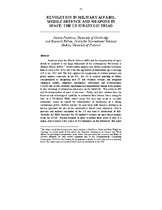| dc.contributor.author | Pretorius, Joelien | |
| dc.date.accessioned | 2012-10-31T13:31:19Z | |
| dc.date.available | 2012-10-31T13:31:19Z | |
| dc.date.issued | 2005 | |
| dc.identifier.citation | Pretorius, J. (2005). Revolution in military affairs, missile defence and weapons in space: The US strategic triad. Scientia Militaria: South African Journal of Military Studies. 33(1): 72-88 | en_US |
| dc.identifier.issn | 1022-8136 | |
| dc.identifier.issn | 2224-0020 | |
| dc.identifier.uri | http://hdl.handle.net/10566/455 | |
| dc.description.abstract | American plans for Missile Defence (MD) and the weaponisation of space should be analysed in the larger framework of the contemporary Revolution in Military Affairs (RMA).1 Soviet military analysts have written about this revolution from as early as the 1970s, but it was the application of information age technology (IT) in the 1991 Gulf War that captured the imagination of military planners and policy makers, especially in the US. The US is actively pursuing an RMA, conceptualised as integrating new IT into weapons systems and integrated command, control, computers, intelligence, surveillance and reconnaissance (C4ISR) and, in turn, doctrinal, operational and organisational change in the military to take advantage of information dominance on the battlefield. This relates to MD and the weaponisation of space in two ways. Firstly, very few countries have the financial and technological capability to modernise their defence forces along the lines of a US-defined RMA, which means that they may resort to so-called asymmetric means to exploit the vulnerabilities or weaknesses of a strong, conventional power. Ballistic missiles (in association with chemical, biological or nuclear payloads) are one of the asymmetrical threats most commonly cited in speeches and military documents of the US and used as justification of MD. Secondly, the RMA increases the US military’s reliance on space-based military assets for C4ISR. Placing weapons in space to protect these assets is seen as a logical step to ensure a key aspect of US dominance on the battlefield. This paper explores the extent to which the strategic framework of the RMA has a bearing on US MD and space weaponisation arguments. | en_US |
| dc.language.iso | en | en_US |
| dc.publisher | Faculty of Military Science, Stellenbosch University | en_US |
| dc.rights | © Pretorius 2005. This is an Open Access article distributed under the terms of the Creative Commons Attribution License (http://creativecommons.org/licenses/by/2.0), which permits unrestricted use, distribution, and reproduction in any medium, provided the original work is properly cited. | |
| dc.subject | Military | en_US |
| dc.subject | Defence | en_US |
| dc.subject | Weapons | en_US |
| dc.title | Revolution in military affairs, missile defence and weapons in space: The US strategic triad | en_US |
| dc.type | Article | en_US |
| dc.privacy.showsubmitter | false | |
| dc.status.ispeerreviewed | true | |
| dc.description.accreditation | Department of HE and Training approved list | en_US |

